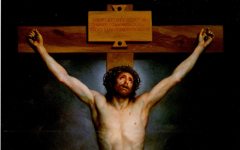Mengs’ Portrait of Winckelmann (1777)

Mengs, Portrait of Johan Joachim Winckelmann (1777) Oil on canvas. Metropolitan Museum, New York
Click image to enlarge.
This portrait of the great writer and archeologist, J. J. Winckelmann, hangs proudly in a corner of the Metropolitan Museum, New York. It was painted by his friend and follower Anton Raphael Mengs about nine years after the sitter's death in 1777.
Click next thumbnail to continue
Hanging right next to it, on the other wall of the corner, is Mengs' own self-portrait which any regular user of this site should immediately recognize as having a strong family resemblance to the portrait of Winckelmann. Only someone still convinced that portraits by true artists portray the exterior world accurately could fail to see the similarity.
Click next thumbnail to continue

L: Mengs, Detail of Portrait of J.J. Winckelmann (1777)
R: Mengs, Detail of Self-portrait (1776), inverted
Click image to enlarge.
Meng's face (near left) is filled with various signs of age and ill-health while Winckelmann's posthumous portrait (far left) is smoothed over and idealized. Even though the archeologist has a longer chin and neck, there is a clear family resemblance including a detail so small it must have been intended: an uneven philtrum on the upper lip, more obvious in the self-portrait than in Winckelmann's portrait.
Click next thumbnail to continue
The museum describes Mengs' art as "truthful".1They are right but for the wrong reasons. Winckelmann's portrait was not intended to be an accurate portrait of the sitter except for casual viewers and history. For the artist, Winckelmann is the erudite archeologist in his mind which is why Mengs took such pains to make his friend resemble his own self-portrait. In the external world, vision is an illusion which continually tricks us. That is why art does too. We learn by looking at art (and using this site) that only self-knowledge is true knowledge. Most then read this portrait as a copy of the external world (illusion); visual poets read it as an illustration of the artist's internal world which, deep down in our own souls, we all share (truth).
More Works by Mengs
Notes:
1. In the catalogue entry on the museum's website.
2. Many great masterpieces, not just portraits, represent the action in a mirror though most art historians remain unaware of them. They include, among others, Velazquez's Las Meninas (1656) and Manet's Olympia (1863).
Original Publication Date on EPPH: 24 Oct 2011. | Updated: 0. © Simon Abrahams. Articles on this site are the copyright of Simon Abrahams. To use copyrighted material in print or other media for purposes beyond 'fair use', you must obtain permission from the copyright owner. Websites may link to this page without permission (please do) but may not reproduce the material on their own site without crediting Simon Abrahams and EPPH.



